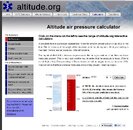According to this website, there is 84% less O2 at 5k ft than at sea level, even though the fractions would be the same.
So, to what value would calibrate their O2 analyzer for Altitude?
How much of a change in altitude would require a different value?
I've seen some more modern analyzers come with a table of values, but I don't have one. Does anyone have a formula?
So, to what value would calibrate their O2 analyzer for Altitude?
How much of a change in altitude would require a different value?
I've seen some more modern analyzers come with a table of values, but I don't have one. Does anyone have a formula?






